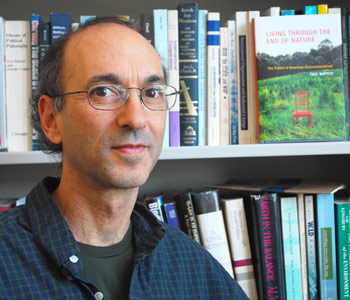Antoni Kapcia
Cuba in Revolution: A History Since the Fifties
Reaktion Books
272 pages, 8.4 x 5.4 inches
ISBN 978 1861894021
Essentially this book was written in an attempt to explain to the interested lay reader why a curious phenomenon still called 'the Cuban Revolution' had managed to survive for so long, despite everything that had happened to it or been thrown against it over five decades. Whatever one feels about the Revolution, its greatest achievement may well be the simple fact of its survival against all the odds. And let us remember what the 'odds' have been: almost five decades of US economic sanctions—still in existence and now easily the longest sanctions in history, repeated crises, the collapse and disappearance of the Soviet Union and the rest of the Socialist Bloc in 1989-91, and finally the slow retirement of Fidel Castro between 2006 and 2008.
I intended the book to go beyond the usual explanations–and, I think, somewhat hackneyed or clichéd explanations–i.e. that the survival of the Cuban Revolution is due to Soviet support, fierce repression, some sort of mindless popular loyalty to the charismatic authority of a single leader, and so on. At best, those reasons can only explain part of the longevity. But for the most part they simply succeed in distorting our understanding. Above all, those explanations miss the enormous complexity of the political system which has been built up in Cuba since 1959.
The book itself was actually based on my inaugural professorial lecture at the University of Nottingham in 2004. In that lecture, 'Reassessing the Cuban Revolution: past, present – and future', I managed to predict that Fidel Castro would stand down in 2009. I got the date wrong by one year, but, in my defence, Castro’s retirement was accelerated by a serious illness which no one foresaw. That prediction was based on my reading of the process of Revolution and the politics of Cuba—a reading which, I hope, has gone into this book.

I have gone away from the common tendency to present the Revolution’s trajectory as a series of often unrelated ‘phases’, a confusing zigzag experience of contradictory changes. The Revolution <em id="">is</em> confusing–but there is a pattern.
In Cuba in Revolution I have gone away from the common tendency to present the Revolution’s trajectory as a series of often unrelated ‘phases’, a confusing zigzag experience of contradictory changes. The Revolution is confusing–but there is a pattern, caused by the basic reality that it is a revolutionary process in a small, underdeveloped and raw material—dependent island, situated right next to the world’s most powerful nation which has, since 1960, been unremittingly hostile to it. That reality has, I argue, led to an inherent tendency to crises. But I argue that each crisis has in turn stimulated 'debate’, or reappraisal, out of which have, in turn, come sustained periods of political consolidation, each taking a particular form. Hence, instead of 'phases’, I suggest 'cycles’, and instead of tracing it all chronologically, I explain it thematically, examining the different processes which have created, won and sustained loyalty.
To my way of thinking, the only way of explaining the Revolution’s survival is to look at those reserves of loyalty built up over the years and then sustained–in enough Cubans for enough of the time–in order to resist external pressures, economic hardship, and repeated frustrations and even failures. 'Loyalty’ is, of course, not necessarily active or even characteristic of the majority of Cubans; it is often passive and even negative, driven by fear of alternatives or custom. But loyalty does exist and is consistently tapped by the leadership. So, in a sense, the book traces the building of what many call 'social capital’ or even a revolutionary version of 'civil society’.
Cuba in Revolution is also, however, very much about nationalism. I have long argued that the roots of the Revolution, its radicalisation after 1959, its development of an idiosyncratic socialism, and also its survival lie in what the Cubans call cubana—a belief in an independent, socially just Cuba Libre. So it is about the radical potential, and the mechanisms, of nationalism. Indeed, one should see 'the Revolution’ as a process of radical nation-building in what used to be called the 'Third World’.
It was all of this which long ago attracted me to Cuba. The book is in fact the result of 38 years of specialising on Cuba but, beyond that, of 42 years of fascination by Cuba. My interest was first aroused by the news coverage in October 1967 of the death of someone of whom I had never heard but whose details seemed fascinating. Che Guevara effectively launched my academic interest in Latin America, an interest which took me to an innovative undergraduate course on the region at University College London, and thereafter on to doctoral research on Cuba. As my supervisor then said, Cuba 'is the only subject to study in Latin America’.
I have also been lucky enough to travel frequently to Cuba–some 30-odd times–which has enabled me to get to know the island pretty well and to make many good and lasting friendships. One of the effects of being in love with a subject or a country is that you always want to tell people about it, explain it, help them share your excitement or enthusiasm. I almost never turn down invitations to speak or to write—I have been writing on Cuba since 1974. And that’s also why I ended up writing Cuba in Revolution.
But I typically write for an academic readership. That means, occasionally, a tendency towards denseness of expression. For example, my first book, Cuba. Island of Dreams, published in 2000, was an achievement in that I comprised in one book-length exposition my theories of the nature and workings of cubana. Although the book was generally well received and does seem to have helped others to get to grips with the subject, parts of it are pretty hard going for the lay reader. Cuba in Revolution, on the other hand, is the most readable exposition of my understanding of Cuba.
I would recommend a prospective reader to start with the final chapter, on Fidel. The rest of the book tends to ignore him. Deliberately. I have always resisted the tendency to focus on the personality of Fidel, to see everything as stemming from or controlled by him. In my view, that tendency not only makes no sense as historiography or as political science, but also distorts our view of the deeper reality. Put simply, one of the reasons why we never seem to understand Cuba is that we are all victims of 'Fidel-centrism’, a viewpoint perpetuated by politicians—especially US presidents—and by a media intent on 'big stories’ or fascinated by 'great men’.
That said, however, to ignore Fidel would be stupid. Therefore, once the book was almost ready, and Fidel took the momentous decision to stand down and not seek re-election as president (in January 2008), it was an obvious epilogue to write to an otherwise largely 'Fidel-free’ study. The result was, I would like to think, one of the best chapters of the book. I was able to distil all that I wanted to say about Fidel’s politics, his role and his contribution, without perpetuating 'Fidel-centrism’ and without losing the importance of the deeper structures of the whole process.
If there is another section to which I would direct readers, I suppose that it might be the chapter 'Thinking the Revolution’, where I tackle the tricky and often misunderstood question of the process’s underlying ideology, looking at its nationalist roots and elements, the nature of its Marxism and the values which make it up.

The only way of explaining the Revolution’s survival is to look at those reserves of loyalty built up over the years and then sustained–in enough Cubans for enough of the time–in order to resist external pressures, economic hardship, and repeated frustrations and even failures.
I would like to think of this book as contributing to breaking down the popular misunderstandings about Cuba. I have sought to combine a readable and concise form with a genuinely novel interpretation of Cuba’s reality, one that arises from my close familiarity with Cuba but also from rigorous research. In other words, I would love it if I had found the academic’s Holy Grail of writing a readable—popular?—book that says something serious and new, the result of real research.
I also want, as ever, to say something significant about Cuba without falling into those traps of partisan writing to which Cuba has always been subject. I do have my views on Cuba and its Revolution, of course – how could I not? But I always try to steer a course between what I call the 'solidarity’ camp (where the need to defend the Revolution leads to uncritical and unsubtle judgements) and the 'anti’ camp (where nothing in Cuba, except perhaps the social achievements of the 1960s, is worth extolling). I don’t seek a 'middle ground’ equidistant from those two positions. I’m more partisan than that. But I do seek a position that points out that Cuba is different, is worth investigating, and is worth appreciating as a complex, and not simple, reality. I hope the book manages to shift the centre of gravity on the understanding of Cuba more towards what I feel is the truth–rather than the truth that people want to exist.




We don't put paywalls. We don't distract you with ads. We don't sell your data.
Please help to keep this running!